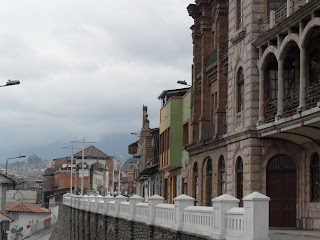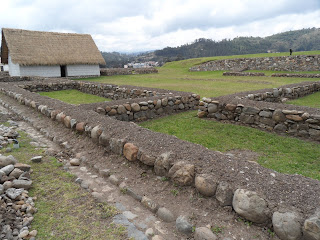 |
| Quito |
The journey begins, as do most in Ecuador, in Quito, which seems to be the hub of the wheel. While Guayaquil down south is the largest city, many of the places worth visiting seem to be within a reasonable journey of the capital city. Further posts will bring descriptions and pictures of the jungle and the Andean Highlands, the Cloud Forest and the beach, and finally from the site of my volunteer position three hours southeast of Quito.
 |
| The hillside to the West of Old Town (the Centro Historico) |
But first, Quito. The most striking feature of the city is that it is crammed in between rolling hills and mountains in the Andes, but spills up on to the hills. The capital has an Old Town (the Centro Historico) and a New Town, which contains an interesting area known as Mariscal. The city is overlooked by a large statue on a hill called El Panecillo, built fairly recently (1976) and reminiscent of Christ the Redeemer in RIo de Janeiro. From that hill, or another nearby hill topped by the Parque Itchimbia you get a great look at the Centro Historico.
 |
| El Panecillo |
The most dominant feature when looking down from above is the Bascilica del Voto Nacional, named such despite the lack of an actual domed top. The gargoyles on this church are fantastic, with pairs of animals from the Galapagos.
 |
| Bascilica del Voto Nacional and Old Town |
 |
| Check out the gargoyles when you blow up this picture |
Walk down the hill and within a few blocks you are in the heart of the Old Town, a 16th century European town mixed with modern Ecuadorian touches. La Ronda is a street that, with a little more money invested, could be located in any country in Western Europe.
 |
| La Ronda |
In addition, Quito's Old Town is where the government of Ecuador resides. The Grand Plaza is a perpetually bustling square with the president's house on the west side, the Congress on the south side and administrative offices on the East, surrounding a statue.
 |
| The Grand Plaza |
The rest of Quito seems to be on the nicer, cleaner end of big Third-World cities. There is quite a bit of noise and some traffic congestion, but you can get around. There are a lot of cabs which don't cost too much (most journeys are about $1-3, going up to $10 or so to get all the way across town). Buses are just a quarter and are very orderly. The pollution is noticeable and gas here is quite cheap (about $1/gallon for diesel, $1.50 for unleaded and $2 for super). It is definitely not up to first-world pollution standards, however.
One annoyance in Quito is they have two main bus stations and at least one other small one, which makes it very difficult to go through Quito on your way to somewhere else. You may have to take a city bus or taxi between bus stations.
I will leave the adventures outside Quito for the next blog entries.










































